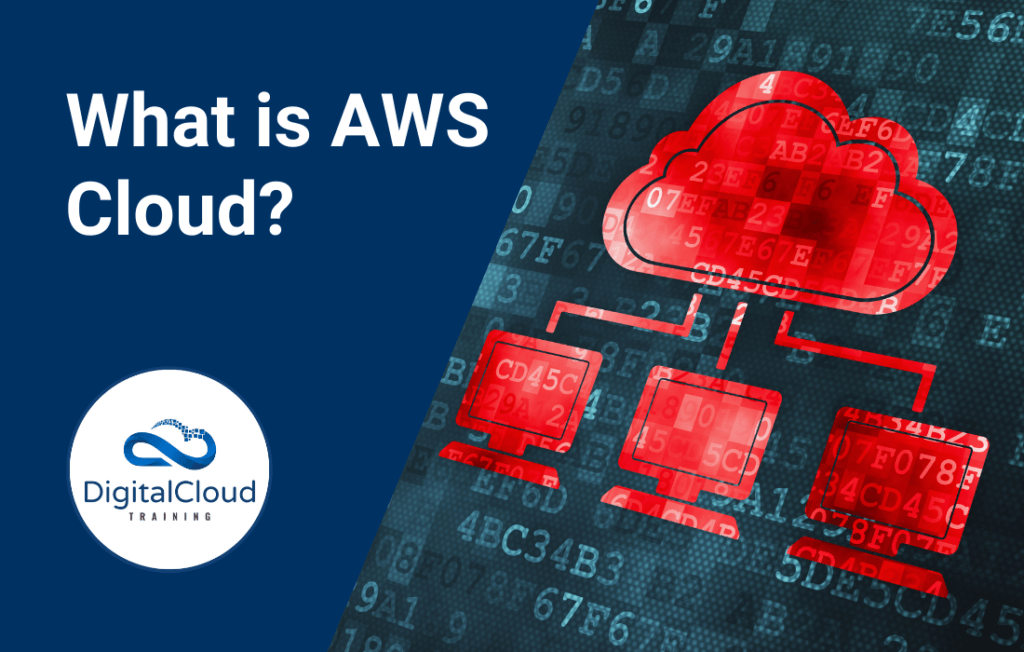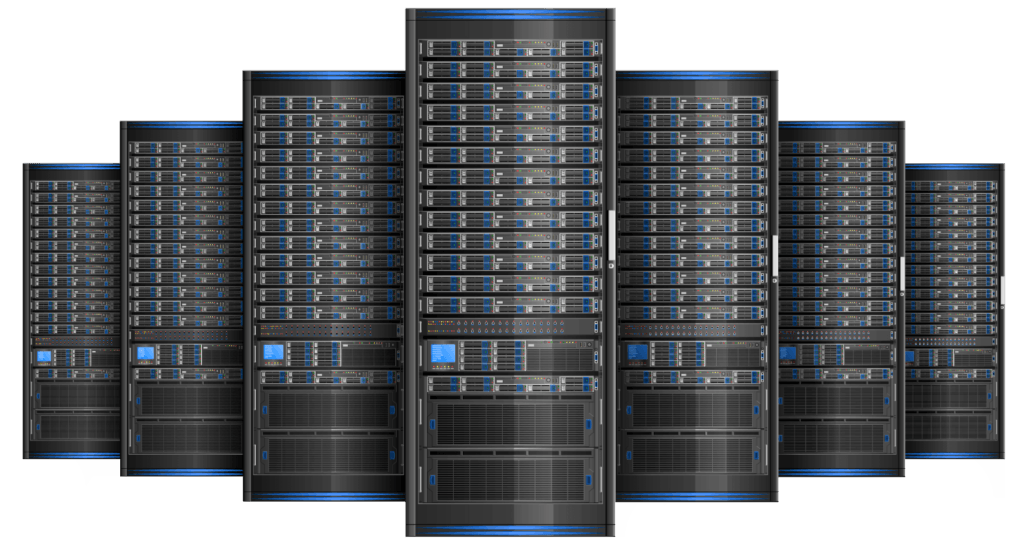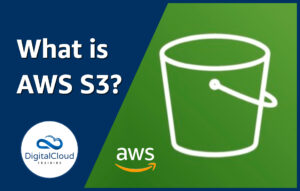What is AWS Cloud?
Please use the menu below to navigate the article sections:

Before we answer the question “What is AWS Cloud” let’s explore who and what AWS is. AWS is simply an acronym that stands for “Amazon Web Services”, but the “cloud” part of it… well, let’s just say that “cloud” has nothing to do with the weather, but rather everything to do with a new and powerful way of using technology.
In this article, we’ll be taking a look at the big picture of how AWS got started, the problem they solved, and why it’s so important. Let’s start off by introducing the history/concepts behind cloud tech and then dive into a real-world story of how one company uses AWS.
The Cloud
Have you ever seen a spy movie where the ‘good guys’ need to infiltrate a data center in order to gather vital information for their plans? Well, these types of data centers actually exist and have a huge role in how the internet works. Everyday people can access these data centers to do all sorts of things like hosting a website or run machine learning tech!
Big companies like Amazon, Google, and Microsoft have built dozens of HUGE data centers around the world. These data centers support Google’s Search Engine, Amazon’s shopping website, and Microsoft’s business technology. But what many people don’t know is that these same companies also allow anyone with a free-to-start account to use these same services. Best part is, no spy skills are required!
What does that mean for you? Well, Digital Cloud Training provides awesome AWS training to help students like you get started on your cloud journey. But let’s start by talking about how cloud got started in the first place and some of the problems companies used to face pre-cloud days.
 The Problems
The Problems
Before cloud technology, every company that wanted to incorporate servers into their business had to purchase big, expensive server racks. Not only that, but these companies also had to rent out space for the servers and pay for 24/7 AC to keep these computers cool. They also had to guess how their web services would’ve been utilized and then provision estimated capacity instead of being able to just pay for whatever they used.
This ended up being a very expensive and slow process, so much so that startups/small businesses had a hard time just paying the upfront costs to simply test their business idea. Now, if these same companies failed in their first year or two, (or before they could pay off the costs of the servers), they’d still be stuck in a contract to pay for servers they were no longer using. Lots of companies faced this type of tough situation. It was these sets of problems that led Amazon to believe an innovative solution was needed to meet the shifting demands of an ever-changing market.
The Solution
Amazon’s online shopping website had already been gaining popularity for a few years when they decided to announce that the very IT infrastructure that powered their e-commerce activities would be made available to everyday users for their own projects and business ideas. In 2002, Amazon Web Services was created and a few years later in 2006 is when they launched their first cloud products, (Happy 15th Birthday, EC2!). This was a big game-changer for the everyday person because it meant that both small and big businesses benefited in a few HUGE ways. With AWS technology, the smallest of teams could now test their ideas and build out their businesses without huge financial commitments due to a few key benefits of cloud tech.
The Benefits
According to AWS, there are six main benefits of adopting the cloud:
- Trade capital expense for variable expense
- Benefit from massive economies of scale
- Stop guessing capacity
- Increase speed and agility
- Stop spending money running/maintaining data centers
- And go global in minutes
Any of the above benefits in and of itself would be enough for any business to consider migrating to the cloud. The fact that AWS offers ALL of these benefits is a powerful force in many businesses’ decisions to incorporate cloud technology into their business endeavors. Let’s look at each of these benefits in a bit more detail.
Trade capital expense for variable expense
This is essentially a fancy way of saying that you only pay for what you use. Instead of spending capital expenses, (like investing heavily in data centers and servers), you can choose to consume cloud services that have variable expenses, (for example, using a server for one hour for testing and then canceling it). This way you only pay for exactly how much you consume.
Benefit from massive economies of scale
The more people use AWS the cheaper it gets over time. It might seem counterintuitive with a supply/demand mindset but that principle doesn’t apply here. The idea here is that the closer data centers are to being used to full capacity the less wasted resources there will be on AWS’ side of things thus allowing AWS to keep prices down for everyone.
Stop guessing capacity
Gone are the days where companies would be stuck with expensive idle resources or limited by too little capacity. With AWS you have services like Auto-Scaling Group that will adjust your capacity in and out as needed. You can access as much or as little capacity as circumstances require.
Increase speed and agility
As you start to learn how to use AWS, you’ll realize that servers and IT services are a click away. What used to take weeks can now happen in minutes due to fast cloud deployments. This enables companies to dramatically increase agility and to save money and time.
Stop spending money on running/maintaining data centers
The less money companies spend on maintaining data centers, the more they can spend on projects that directly affect their customers.
Go global in minutes
Not only are speed and agility increased but also the potential for global impact is greatly enhanced by the cloud. Because AWS has established a global network of data centers and edge locations you can deploy your application to multiple regions around the world with just a few locations. Reduce latency and improve the user experience while still keeping costs extremely low by using AWS.

The Services
At the time of writing, the number of AWS cloud products have already exceeded 200! I’ve included a list of some of the most popular ones below. If at first glance you don’t understand what a service does, that’s okay! There are so many services that no one person can master them all. Even AWS’ employees have to become experts at a select few as it is impossible to know everything about all these services. Our AWS courses offer both lectures and hands-on training focused on practical use cases so you can get started using AWS.
Compute
- Amazon EC2 (Elastic Cloud Compute) is a service for provisioning virtual machines in the cloud.
- AWS LightSail is like EC2 but it automatically manages things like storage and networking so you can focus on deploying your application.
- AWS Lambda is a function-based computing service that helps companies save way more money than if they were to use EC2.
Storage
- Amazon S3 (Simple Storage Service) is like Dropbox but more versatile to meet more needs.
- Amazon EBS (Elastic Block Store) is combined with EC2 to offer storage to your virtual machines.
Migration
- AWS DMS (Database Migration Service) is used to migrate your database from on-prem to cloud (simple enough, right?).
- AWS SMS (Server Migration Service) is similar to DMS but designed for servers.
- AWS Snowball is a hardware device that AWS can send to your data center to increase cloud migration speed.
Security
- AWS IAM (Identity and Access Management) is used to create users and manage policies within your organization.
- AWS WAF (Web Application Firewall) offers application-level protection and blocks common attacks like SQL injections.
- AWS Organizations allows users to create groups of AWS accounts and manage company users at a high level.
- AWS Shield is AWS anti-DDoS service for web apps.
- Amazon Macie is how you protect sensitive information while still adhering to security policies.
Database
- Amazon RDS is a relational database service that is easy to start up.
- Amazon DynamoDB is the NoSQL DB that is simple and cost-effective to use.
- Amazon ElastiCache enables DB caching in the cloud.
- Amazon RedShift is the data warehouse solution where you can do big picture queries on your data.
Analytics
- Amazon Kinesis is an AWS data stream and analytics service that can transform and process data as it comes in.
- Amazon EMR (Elastic Map Reduce) is an AWS big data processing solution.
Management
- Amazon CloudWatch helps monitor your cloud resources like EC2 and Databases.
- AWS CloudTrail is your main way of tracking who takes what actions in your AWS environment.
Internet of Things
- AWS IoT Core is an AWS service that helps you to interact with all of your IoT devices like home appliances and cars.
Developer Tools
- AWS CodeStar is an AWS service that is used for managing software development projects
- AWS Cloud9 is an IDE (integrated development environment) that you can use to run commands natively in AWS.
Mobile
- Amazon Cognito is used for making signing up for apps easier.
- AWS Device Farm is a way to quickly test your apps on hundreds of different mobile devices.
Business Productivity
- Amazon Alexa for Business (much like the name implies) is an easy way to get started using Alexa for your business needs.
- Amazon Chime is Amazon’s version of Zoom.
- Amazon WorkDocs is Amazon’s version of Google Drive.
- Amazon WorkMail is Amazon’s version of Gmail.
Desktop & App Streaming
- Amazon WorkSpaces is a cool service that allows you to remote control desktops from your cloud environment.
Artificial Intelligence & Machine Learning
- Amazon Lex can create chatbots for your web applications extremely fast.
- Amazon Polly is used for text-to-speech solutions.
- Amazon Rekognition is an AI technology that recognizes faces and gives you data based on the photos and videos you process.
- Amazon SageMaker is AWS’ machine learning service that helps you train and deploy machine learning models.
- Amazon Transcribe & Translate are language tools that can help you in a variety of ways as your business sees fit.
AR & VR
- Amazon Sumerian is AWS’ foot in the door to the AR/VR industry and provides high-quality VR experiences.
Game Development
- Amazon GameLift is a managed service by AWS used for managing game servers without you having to take your game offline.
If you’ve read through the above list of services, then congrats! You already understand more about AWS’ offerings than most of the world. As was previously mentioned, this is just a small selection of the core services AWS offers. There is so much more to learn about how these services work and what solutions they can offer. One example of a company that has successfully embraced a number of AWS services is Netflix.

The Story
Maybe Netflix isn’t your number one streaming choice, or maybe it is! Either way, there’s no denying that Netflix is one of the biggest success stories of our generation. Have you ever wondered how exactly they became so successful? I’m not sure that there’s one simple answer to that deep question. But one part of the puzzle is Netflix’s early adoption of cloud technology.
Those at Netflix say that AWS has played a crucial role in Netflix becoming such a huge success. Only those who work at Netflix know the exact details of their cloud architecture but it’s obvious that they make great use of S3 Buckets and EC2 instances to make sure their movies and shows are available for customers around the world. I’m sure they also use a fair amount of security tools and analytic services so as to protect and improve their business.
Netflix wouldn’t exist as we know it today if it weren’t for AWS Cloud. You can read about the story in detail on the AWS website. But suffice it to say that because Amazon’s IT infrastructure, (think spy movie data centers), was made available to a small group of innovative entrepreneurs, Netflix was able to leverage storage and computing services to reach the global audience it reaches today.
Positive Disruption
Because of cloud technology, the world will never be the same. Small teams like Netflix were at the start, are constantly upsetting giant Goliaths across all industries due to the extreme advantages provided by cloud technology (among other things). This is something that you can be a part of too because the cloud is still growing in popularity. Every day companies around the world are discussing whether they should migrate to the cloud or not. So if you’re knowledgeable about how AWS works you could definitely find yourself in a cloud architect or cloud engineer position making over $100,000 every year.
If you’ve ever thought that a career in tech sounded interesting or like to understand how the internet really works then there are TONS of opportunities for you to work! Of course, you need to understand how the cloud works but once you do you’ll be invaluable to so many businesses around the world.
Learn how to Master the AWS Cloud
AWS Training – Our popular AWS training will maximize your chances of passing your AWS certification the first time.
Membership – For unlimited access to our cloud training catalog, enroll in our monthly or annual membership program.
Challenge Labs – Build hands-on cloud skills in a secure sandbox environment. Learn, build, test and fail forward without risking unexpected cloud bills.




